Cholesterol
What is hyperlipidaemia or high cholesterol?
Hyperlipidaemia refers to elevated levels of lipids (fats), including cholesterol and triglycerides, in the blood. Cholesterol is made in the liver from fatty foods that we eat. A certain amount of cholesterol is present in the bloodstream as it is needed for the repair and manufacture of new cells.
Most people with hyperlipidaemia have no symptoms. However, hyperlipidaemia is associated with an increased risk of coronary heart disease (CHD), a thickening or hardening of the arteries that supply blood to the heart muscle. CHD, in turn, can result in angina pectoris (chest pain), a heart attack, or both. Because of these risks, treatment is recommended for many people with hyperlipidaemia.
Lipid levels can almost always be lowered with a combination of diet, weight loss, exercise and medication. As lipid levels fall, so does the risk of developing CHD, as well as the risk of suffering a stroke. It is not too late if CHD is already present. Lipid-lowering treatment in people with CHD can be life saving.
Other risk factors for coronary heart disease
In addition to hyperlipidaemia, there are a number of other factors that increase the risk of CHD and its complications.
The following are CHD-risk equivalents. Patients with these underlying medical problems are thought to be at the same risk for complications of heart conditions as patients with known CHD:
- diabetes mellitus, types I and II;
- symptomatic carotid artery disease (e.g. stroke or transient cerebral ischemia);
- peripheral arterial disease (e.g. claudication); and
- abdominal aortic aneurysm.
Other characteristics that increase the risk of CHD include:
- smoking;
- hypertension (blood pressure 140/90 or use of blood pressure medication);
- family history of premature CHD in a first-degree relative (parent, child or sibling). In males: first-degree relatives younger than 55 and in females: first-degree relatives younger than 65;
- gender i.e. men have a higher risk of CHD than women at any age; and
- age i.e. there is an increasing risk of CHD with increasing age.
Causes of high cholesterol
For the majority of people, their cholesterol level is determined by both hereditary and dietary factors. Some people have naturally high blood cholesterol levels, due to a hereditary condition known as familial hypercholesterolaemia (FH). In South Africa this is very common in the Afrikaner, Indian and Jewish communities. People from these ethnic groups often have a family history of premature heart disease (heart attack or related death in men before the age of 55 and in women before the age of 65).
Risk factors for high cholesterol
- Genetics: family medical history (especially of heart attacks or very early heart-related deaths).
- Age: between the ages of 20 and 65, total cholesterol levels increase steadily, whereafter they decrease slightly in men and tend to plateau in women.
- Gender: women have higher HDL (high-density lipoprotein) cholesterol levels than men and therefore have less risk of developing heart conditions than men. With menopause, the low-density lipoprotein (LDL) increases and their risk equals that of men.
- Diet: a diet too high in saturated fat, cholesterol and refined sugars, e.g. white bread, cake and sweets, can increase cholesterol levels.
- Weight: overweight people tend to have higher LDL and lower HDL levels and thus have an increased risk.
- Exercise: the more active you are, the higher your HDL levels (and the other way around). It also helps control weight and blood pressure.
- Smoking: this may contribute to increased cholesterol levels.
- Stress: this has been associated with increased cholesterol levels.
- Alcohol: excess intake may contribute to increased cholesterol levels.
Who should have their cardiovascular health risk assessed?
Current guidelines advise that the following people should be 'screened' to assess their cardiovascular risk:
- all adults aged 40 and older; and
- adults who have:
o a strong family history of early cardiovascular disease; this means you have a parent or sibling who developed heart disease or a stroke (father or brother before they were 55; or mother or sister before they were 65); and/or
o a first-degree relative (parent, sibling or child) with a hereditary lipid disorder, for example familial hypercholesterolaemia or familial combined hyperlipidaemia.
If you already have a cardiovascular condition or diabetes, then a screening is not necessary, as you already form part of the high-risk group.
What does the screening involve?
A doctor or nurse will do a blood test to check your cholesterol and glucose (sugar) level. They will measure your blood pressure and record your smoking status. A score is calculated based on these measurements, your age and gender using a risk assessment calculator called the Framingham Risk Score. An adjustment to the score is made for certain other factors such as strong family history and ethnic origin.
The following levels of blood lipids are generally regarded as desirable:
- Total cholesterol (TC): 5.0mmol/l or less.
- Low-density lipoprotein (LDL) cholesterol after an overnight fast: 3.0mmol/l or less.
- High-density lipoprotein (HDL) cholesterol: 1.2mmol/l or more.
- TC/HDL ratio: 4.5 or less (that is, your total cholesterol divided by your HDL cholesterol). This reflects the fact that for any given total cholesterol level, the higher the HDL, the better.
What does the assessment score mean?
You are given a score as a percentage chance. So, for example, if your score is 30%, this means that you have a 30% chance of developing a cardiovascular condition within the next 10 years. In other words, in this example, three out of 10 people with the same risk factors as you will develop a cardiovascular condition within the next 10 years.
Note: The score cannot determine that you will be one of the three, it is merely an estimation.
You are said to have a:
- high risk if your score is 20% or more;
- moderate risk if your score is between 10% and 20%; and
- low risk if your score is less than 10%.
Who should be treated to reduce their cardiovascular health risk?
Treatment to reduce the risk of developing a cardiovascular condition is usually offered to people with a high risk; that is, people with:
- a risk assessment score of 20% or more;
- an existing cardiovascular condition (to lower the chance of the condition worsening or of developing a further condition);
- diabetes. If you have diabetes, the time that treatment is started to reduce cardiovascular risk depends on factors such as your age, how long you have had diabetes, your blood pressure and if you have any complications associated with diabetes; and
- certain kidney disorders.
The following people should also have drug treatment to lower their cholesterol level, regardless of any calculated risk. The risk calculator may not necessarily take into account these people who have a high risk of developing fatty plaques in their arteries (atheroma):
- People with a total cholesterol level of more than 7.5mmol/l or an LDL level of more than 5mmol/l.
- People with familial (hereditary) lipid disorders.
What treatments are available to reduce the risk?
If you are at high risk of developing a cardiovascular condition then drug treatment is usually advised along with advice on lifestyle issues. This usually includes:
- drug treatment to lower your cholesterol level, usually with a statin drug. No matter what your current cholesterol level, drug treatment is advised. There are several brands of statin drugs. They work by blocking an enzyme (chemical) which is needed to produce cholesterol in the liver. The aim is to reduce total cholesterol to less than 5.0mmol/l and LDL cholesterol to less than 3.0mmol/l;
- drug treatment to lower blood pressure if your blood pressure is high;
- a daily low dose of aspirin - depending on your age and other factors. Aspirin helps to prevent blood clots from forming on patches of atheroma; and
- where relevant, to encourage you to change your lifestyle, such as to:
o quit smoking;
o eat a healthy diet;
o maintain a healthy weight;
o engage in regular physical activity;
o avoid drinking alcohol.
You may be advised to consult the following specialists:
- a cardiologist (heart specialist);
- an ophthalmologist (eye specialist);
- a dietician to help you to lose weight and maintain a healthy diet;
- a specialist ‘quit smoking' clinic / programme; and/or
- a supervised exercise programme.
Healthy diet
Changing from an unhealthy to a healthy diet can reduce your cholesterol level. However, dietary changes alone rarely lower a cholesterol level enough to change a person's risk of having a cardiovascular condition from a high risk to a lower risk category. However, any extra reduction in cholesterol due to diet will help. A healthy diet has many other benefits in addition to reducing the level of cholesterol.
Briefly, a healthy diet comprises of:
- about five to nine portions of a variety of fruit and vegetables per day;
- starch-based foods (such as cereals, wholegrain bread, potatoes, rice and pasta);
- minimal fatty food such as fatty meats, cheeses, full-cream milk, fried food and butter, etc. Use low fat, mono-, or poly-unsaturated spreads;
- two to three portions of fish per week, at least one of which should be an 'oily' fish;
- lean meat or poultry, such as chicken;
- vegetable oil such as sunflower, grapeseed or olive oil for frying foods; and
- minimal salt in food and minimal salty, processed foods.
How much do I benefit from a reduced cholesterol level?
If you have an increased risk of developing an atheroma-related condition, your risk can be reduced by up to 30% if your cholesterol level is lowered to a target level. If you already have an atheroma-related condition, lowering the cholesterol level reduces your risk of further problems.
 TransmedBanner4.jpg)

